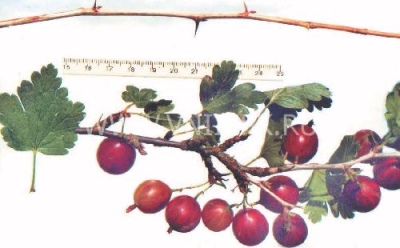
- Authors: O. A. Medvedeva, I. S. Studenskaya (Leningrad fruit and vegetable experimental station)
- Appeared when crossing: Mysovsky 17 x Industry
- Year of approval: 1994
- Growth type: medium-sized
- Description of the bush: compact, under crop load - spreading, erect
- Escapes: medium thickness, directed upwards and to the sides; growing - arched curved, gray with a light green top
- Thorniness: medium
- Thorns: one- and two-part, 0.5-0.7 cm long, thin, not very sharp, light green
- Sheet: medium in size, dark green, shiny, medium density, smooth, concave along the main veins, lobes 3-5
- Spike location: directed perpendicular to the shoot, located at the bottom of the shoot
The gooseberry variety Salut was obtained at the Leningrad Fruit and Vegetable Experimental Station. Salute boasts high resistance to various diseases, pests, temperature changes.
Description of the variety
The variety has medium-sized bushes, they are quite compact, the height of each plant is about 100-120 centimeters. Vegetation with thorns, while the thorniness is average.
The shoots are of medium thickness, they are directed to the sides and upward. The leaves are of medium size, their color is dark green, the surface of the leaf plates is shiny, of medium density.
The thorns on the bushes are single and bipartite, thin, their color is light green. The thorns grow perpendicular to the shoots.
The flowers are of medium size, their shape is bell-shaped. The inflorescence is one-flowered and two-flowered.
Characteristics of berries
Ripe berries are large in size. The mass of the berries ranges from 2.4 to 6.5 grams. Their color is bright pink, when fully ripe, it becomes dark red.
The peel on the fruit does not have pubescence, its thickness is medium. The gooseberry pulp is quite thick and juicy.
Taste qualities
Ripe gooseberries taste sweet and sour. The tasting score was 4.8 points.
Ripening and fruiting
The gooseberry variety Salute is a medium-ripening variety.
Yield
Salute boasts a high yield level. It will be possible to collect about 5.5 kilograms of ripe berries from one bush. About 120-150 centners are collected from one hectare of land.
Landing
Landing is carried out according to the scheme 1x1.5 meters.

Growing and caring
Gooseberries can be planted both in spring and autumn. In this case, you should choose the most illuminated place on the site. The culture prefers sandy, sandy loam, loamy soils. The chosen location should also be well protected from the winds.
Planting pits should be about 30 cm deep, about 60 cm in diameter. Rotted manure, superphosphate, potassium salt (wood ash can be used instead), limestone are introduced into each hole. Peat can be added to improve aeration.
Young seedlings are planted strictly straight without slopes. Moreover, the root collar must be deepened by no more than 4-5 cm. The lower part is sprinkled with earth.
Immediately after planting, the ground around the bushes is slightly compacted. Each plant is watered abundantly (5 liters of water per planting).
Gooseberries do not tolerate excess moisture, so you should not moisturize them too much. Watering is best done in the evening, the liquid needs to be poured only under the root, it should not get on the stem and leaves.
During the period of fruit ripening, watering can be increased. At this time, it is recommended to moisten the culture evenly and abundantly so that the berries do not crack.
The first loosening will need to be done in early spring. The next loosening is carried out in the first half of June, when there is an active vegetation and the formation of ovaries.
Further, the procedure is carried out in late summer - early autumn, when the entire crop has already been harvested. Before the onset of the winter season, the land around the bushes is carefully dug up, during the same period, mineral and organic fertilizing is introduced.
Pruning of plants also plays an important role. It provides, among other things, a high yield of the crop. Moreover, this procedure is also carried out on young bushes.
In the first year, it will be necessary to remove all damaged and dead branches, in the second year, several of the healthiest and strongest branches must be selected, the rest are cut out at the base. In the third year, it will be necessary to leave another 3-4 such branches, remove the rest.
It is important to apply fertilizers on time. To compensate for the lack of nutrients, you can use complex mineral and organic formulas. They can be bought ready-made at a specialist store.
Sometimes a mixture is prepared, consisting of humus (half a bucket), superphosphate (50 grams), you can also add a little potassium sulfate (25 grams) there.
After applying top dressing, the soil around the bush must be carefully loosened. After the flowering period, you can additionally use mullein solution. To prepare it, you will need to mix the mullein with water in a ratio of 1 to 5. One gooseberry bush should have at least 5 liters of such a nutrient solution.
After the winter cold, the bushes are recommended to be treated with boiling water. This procedure will avoid the early appearance of various pests and diseases. It is best to carry out this treatment with a spray bottle.




In order for the gooseberry to produce a good harvest, it is necessary to devote time to disease prevention.




































































